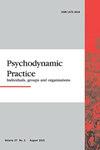精神分析中的游戏和活力的精神动力学实践杂志评论
IF 0.4
Q4 PSYCHOLOGY, CLINICAL
引用次数: 0
摘要
. . . . 第二代场理论受到叙事学和法国结构主义理论的影响。Ferro引用了Francesco Corrao(1986)的观点:两个人之间没有分析,但每次分析都涉及一个群体……在会议中出现的人物…病人和分析师的共同创造。Ferro通过将场理论与“Bion最伟大的发现:α函数或无意识醒梦. . . .”结合起来介绍了第三代,Ferro的场是第四代,这是一个后Bion的场,在这个场中,Bion对无意识醒梦思想的激进概念与叙述性相结合。(罗斯,2020)本文章由计算机程序翻译,如有差异,请以英文原文为准。
Review for journal psychodynamic practice of playing and vitality in psychoanalysis
. . . . Second-generation field theory was influenced by narratology and French structuralist theory. Ferro cites Francesco Corrao (1986) who proposed: there is no analysis between two people, but that each analysis involves a group . . . of characters that emerge in the session . . . the joint creation by patient and analyst. Ferro introduces the third generation by joining field theory with “Bion’s greatest discovery: alpha-function or unconscious wakingdreaming . . . .Ferro’s field is fourth generation, a post-Bionian field in which Bion’s radical conception of unconscious waking dream thought is mated with narratology. (Roos, 2020)
求助全文
通过发布文献求助,成功后即可免费获取论文全文。
去求助
来源期刊

Psychodynamic Practice
PSYCHOLOGY, PSYCHOANALYSIS-
CiteScore
0.90
自引率
0.00%
发文量
41
期刊介绍:
Psychodynamic Practice is a journal of counselling, psychotherapy and consultancy and it is written for professionals in all fields who use psychodynamic thinking in their work. The journal explores the relevance of psychodynamic ideas to different occupational settings. It emphasizes setting and application as well as theory and technique and focuses on four broad areas: •Clinical practice •The understanding of group and organisational processes •The use of psychodynamic ideas and methods in different occupational settings (for example, education and training, health care, social work, pastoral care, management and consultancy) •The understanding of social, political and cultural issues
 求助内容:
求助内容: 应助结果提醒方式:
应助结果提醒方式:


